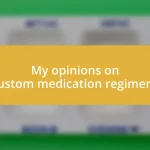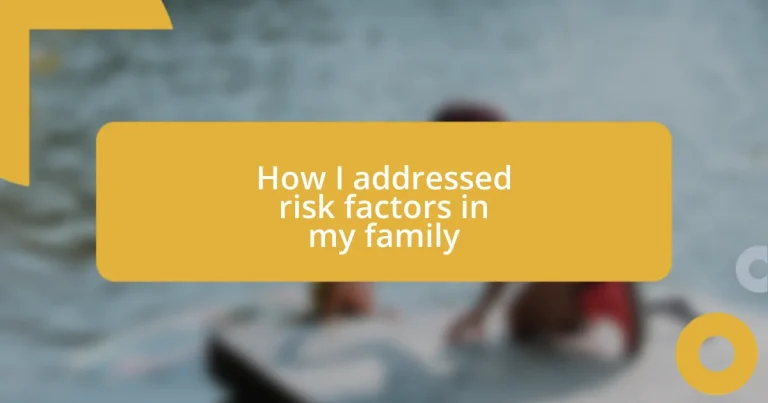Key takeaways:
- Open discussions about family health history can uncover critical risk factors, including both physical and mental health issues.
- Creating a structured risk assessment plan empowers families to address health concerns collectively through shared goals and regular check-ups.
- Building a supportive environment and using technology for tracking health improvements fosters accountability and encourages positive lifestyle changes within the family.

Identifying family risk factors
Identifying family risk factors can feel overwhelming at first, but it’s an essential step in safeguarding our loved ones. I remember sitting around the dinner table, sharing stories about our health, when my aunt suddenly mentioned her struggles with high blood pressure. That moment hit home for me—it made me realize that these conversations can uncover patterns that we might not even notice at first.
As I delved deeper into my family’s health history, I found that several relatives had experienced heart issues, which prompted me to reflect on my own lifestyle choices. It made me wonder—how many of us ignore these signs until they become critical? By openly discussing our family’s past, I began to grasp not just the physical risks, but also the emotional weight that comes with these histories.
Addressing these risk factors requires a level of honesty that can be uncomfortable. I’ll never forget the anxiety I felt when my mom opened up about her struggle with anxiety and depression; it was a vulnerable moment, yet it highlighted the importance of recognizing mental health as a risk factor too. This realization shifted how I viewed our family’s overall well-being—understanding these connections truly inspired me to take proactive steps for my own health and that of my loved ones.

Evaluating health history
Evaluating my family’s health history has been more than a mere checklist—it’s a journey filled with reflections and revelations. When I first started this process, I sat down with my grandparents, listening intently as they recounted their experiences with diseases that had shadowed our lineage. One story struck me particularly hard: my grandmother shared how her mother’s struggle with breast cancer had impacted her own health choices. It made me appreciate the threads that weave through generations, reminding me that understanding our past offers a crucial roadmap to making informed decisions today.
As I meticulously documented our health patterns, I found it essential to consider not just physical ailments but psychological factors too. For example, when I learned that my uncle faced battles with addiction, I realized how mental health can intersect with physical well-being. This insight added another layer to my understanding of risk factors; it’s not solely about heart disease or diabetes—emotional struggles can also influence our physical health. How many times have I unknowingly brushed off a headache thinking it was stress? Recognizing these overlaps has prompted me to adopt a more holistic approach to my health.
I often encourage my friends to take similar steps in their evaluations. My own experience taught me the power of open communication—it’s transformative. During one family gathering, we started an open dialogue about heart health and the importance of regular check-ups. As we shared stories, I could see my cousin’s eyes widen as she learned her own family history could serve as a guiding light rather than a burden. This collective knowledge empowers us to face risks head-on, and it’s a reminder that, while our family history may include struggles, it also carries wisdom that can shape our futures.
| Health Issue | Family Member |
|---|---|
| High Blood Pressure | Aunt |
| Heart Disease | Grandfather |
| Breast Cancer | Great-Grandmother |
| Anxiety | Mother |
| Addiction | Uncle |

Creating a risk assessment plan
Creating a risk assessment plan involves taking a proactive approach to understanding and mitigating family health risks. I recall discussing our family’s health with my siblings during a road trip; the conversations flowed as we shared our various concerns and motivations for healthier lifestyles. This dialogue sparked an understanding that creating a formalized plan would help us identify who might be at risk for what and, ultimately, guide us toward preventive measures. By laying it all out, we could assess where we stand and what actions to prioritize.
To develop a comprehensive risk assessment plan, I focused on several key elements:
- Health History: Chart out family medical history to identify prevalent conditions.
- Lifestyle Factors: Evaluate habits like diet, exercise, and stress levels that might influence health risks.
- Screening Protocols: Establish regular check-ups and screenings based on identified risks, such as cholesterol or blood pressure checks.
- Emotional Well-Being: Include mental health considerations by discussing past family struggles with anxiety or depression.
- Action Steps: Set specific and achievable health goals to minimize identified risks, such as eating more vegetables or incorporating regular exercise.
This structured approach not only clarified the potential risks I faced but also fostered a sense of teamwork within my family. It became clear that tackling these issues together makes the journey more manageable and empowering.

Implementing preventive health measures
Implementing preventive health measures became a priority once I recognized the risks highlighted in our family discussions. For instance, after learning about my aunt’s struggles with high blood pressure, I decided to incorporate more heart-healthy foods into our family meals. This simple change wasn’t just about altering our diet—it led to engaging cooking sessions that turned into bonding moments. Have you ever experienced the joy of cooking as a family? It’s incredible how food can connect us while we simultaneously work on improving our health.
Regular check-ups became non-negotiable in our household. I vividly remember the first time I accompanied my mother to her routine screening. It transformed what could have felt like a daunting experience into an opportunity for support and encouragement. One question lingered in my mind: How often do we avoid these appointments due to fear or denial? I realized that making these visits a family affair not only eases anxiety but also establishes a culture of proactive health that my younger siblings can carry forward.
Education also played a crucial role in our preventive strategy. I took it upon myself to research the importance of certain screenings related to our family history. Sharing these findings with my family opened up discussions about the significance of early detection. For example, as we talked about the risk of breast cancer due to my great-grandmother’s history, my cousin decided to schedule her first mammogram. It was a touching moment that drove home the point: taking charge of our health is not just a personal journey; it’s a commitment we make to each other.

Encouraging open family discussions
Open family discussions create a vital platform for sharing health concerns without judgment. I remember a casual coffee gathering with my parents, where we began to discuss our individual health habits. As we chatted, I could sense a change in the usual atmosphere; it was refreshing to explore these topics freely. Have you ever sat down with family and discovered deeper connections? That day, we learned vulnerabilities can foster understanding, leading us to commit to healthier choices together.
I always try to encourage my siblings to voice their worries and share their experiences. There was a time when my brother hesitated to mention his recurring headaches, fearing they’d be dismissed. But when I opened up about my own anxiety over a family health condition, it felt like a door swung wide open. Suddenly, he felt comfortable enough to share. I’ve found that vulnerability invites vulnerability; isn’t it amazing how one person’s honesty can pave the way for others to share their truths?
In these discussions, I aim to bring light and positivity, making it clear that each voice matters. During one family dinner, I tossed out the idea of a “health check-in” tradition, where we could check in on each other’s goals and struggles. The response was overwhelmingly supportive! I realized then that our conversations could be more than just talk; they could turn into actionable commitments. How often do we overlook the power of simply asking, “How are you feeling today, really?” It’s these genuine moments that build stronger bonds and promote an ongoing dialogue about health and well-being.

Building a supportive environment
Creating a supportive environment within my family has been a game-changer. I remember the day my sister and I decided to create a wellness corner in our home. We filled it with inspiring quotes, family photos, and even a whiteboard for tracking our health goals. Every time I walk by that space, I’m reminded of our commitment to each other. Have you ever created a special place that motivates you? It truly transforms the atmosphere and keeps health at the forefront of our minds.
In addition to physical spaces, emotional support is vital. I recall a particularly tough evening when my father received troubling news about his health. Instead of retreating into silence, we all gathered in the living room. Sharing our feelings, fears, and even a few laughs helped lighten the mood. I realized then how powerful it is to lean on each other during difficult times. It makes me wonder: how often do we underestimate the significance of simply being present for one another?
Finally, establishing routines that prioritize family time has been essential. We set aside Sunday afternoons for our “family check-ins,” where we discuss not only health but also life in general. This ritual has transformed into a safe haven for everyone. I recently listened as my cousin discussed her struggles with managing stress. Her openness sparked a group discussion about coping strategies we could share. Isn’t it uplifting to witness how one conversation can lead to a ripple effect of support? I believe that these moments reinforce our bond and empower each family member to thrive.

Monitoring health improvements
Monitoring our health improvements can sometimes feel like an elusive task, but I’ve found a few effective strategies that work wonders. I remember when I decided to track weekly exercise habits with my family. We created a simple chart where everyone recorded their activities, and you wouldn’t believe the thrill of seeing everyone’s progress! It turned our efforts into a shared journey, transforming individual achievements into collective celebrations. Have you ever experienced that rush when you see the positive changes taking shape before your eyes?
In our family, weekly check-ins became a ritual that enriched our commitment to better health. I could feel a palpable shift during these sessions when my sister would announce her new running distance or my dad’s blood pressure readings steadily improving. It felt like we were all in this together, and seeing each other’s successes encouraged us all to dig deeper. Isn’t it fascinating how celebrating small wins can build momentum toward larger goals?
Additionally, I’ve leaned into technology to help monitor our health as a family. Using apps that track nutrition or fitness has added a layer of accountability. I vividly remember one evening when I shared a health app with my brother; he was skeptical at first, but soon he was engaged and even suggested challenges for us to complete together. That playful competition not only kept us on track but also infused our routine with some fun. It makes me wonder: how can technology enhance our health journeys in ways we’ve yet to explore?














